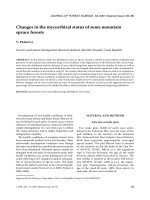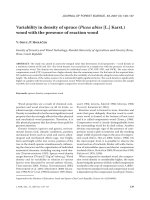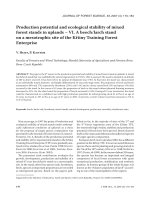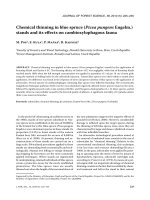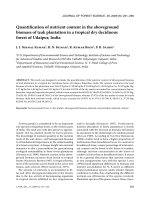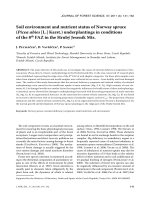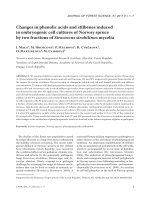Báo cáo lâm nghiệp: "Nutrients in the aboveground biomass of substitute tree species stand with respect to thinning – blue spruce (Picea pungens Engelm.)" doc
Bạn đang xem bản rút gọn của tài liệu. Xem và tải ngay bản đầy đủ của tài liệu tại đây (373.14 KB, 7 trang )
J. FOR. SCI., 54, 2008 (3): 85–91 85
JOURNAL OF FOREST SCIENCE, 54, 2008 (3): 85–91
Forest stands of substitute tree species were estab-
lished in the Czech Republic on those sites where the
declining spruce monocultures could not be replaced
by ecologically suitable tree species. e largest lo-
calities with substitute tree species stands are in the
Krušné hory Mts. (Northern Bohemia), which have
been considered as one of the most heavily air-pol-
luted areas since the sixties of the last century.
In the Forest Region of the Krušné hory Mts., the
substitute tree species stands took up about 36% of
forest land area (UHÚL 2007), i.e. about 41 thousand
ha. e largest percentage of this area is covered
with birch (Betula sp. – 12.4 thousand ha) and blue
spruce (Picea pungens Engelm. – 8.9 thousand ha) or
mixtures of these two species.
In the Krušné hory Mts., the newly planted sub-
stitute tree species stands cannot provide the for-
est production function. But due to an air pollu-
tion decrease, substitute stands are presently in
the good health condition and grow relatively well.
Consequently, they are nowadays at the beginning
of a tree species conversion in the Krušné hory Mts.
In connection with the substitute stand conversion
there have arisen new questions: (a) Is it possible
to remove aboveground biomass from thinning for
chipping? and (b) Does the production of chipping
Supported by the Ministry of Agriculture of the Czech Republic, Project No. MZe 0002070201 Stabilisation of Forest Functions
in Biotopes Disturbed by Anthropogenic Activity under Changing Ecological Conditions.
Nutrients in the aboveground biomass of substitute tree
species stand with respect to thinning – blue spruce
(Picea pungens Engelm.)
M. S, J. N
Forestry and Game Management Research Institute, Strnady, Opočno Research Station,
Opočno, Czech Republic
ABSTRACT: The present paper is the first contribution from the biomass quantification series which is
realized by Forestry and Game Management Research Institute in the Krušné hory Mts. (Northern Bohemia).
This study is aimed at blue spruce substitute stands. Research was done within the blue spruce experiment
Fláje II in the Krušné hory Mts. (800 m above sea level in the spruce forest vegetation zone, acidic category).
Results showed that the aboveground biomass of the investigated substitute blue spruce stand without thin-
ning amounted to approximately 56 thousand kg of dry matter per ha at the age of 22 years. Wood and bark
of branches are the most important parts of the aboveground biomass (ca 40%). Needles and stem wood
accounted for approximately 26 and 28% and stem bark only for 6%. At the age of 22 years, the investigated
substitute blue spruce stand accumulated: N – 336 kg, P – 28 kg, K – 138 kg, Ca – 159 kg, Mg – 28 kg per
hectare. Thinning with the consequent removal of aboveground biomass (54% of trees, 40% of basal area at
the age of 16 years) represented a loss of ca 8.7 thousand kg/ha of total biomass, which contained 53 kg of
N, 5 kg of P, 22 kg of K, 26 kg of Ca and 4 kg of Mg. The removal of biomass in areas previously degraded
by acid deposition may result in the deficiency of Ca and Mg because of their low content in forest soil. On
the other hand, thinning supported the faster growth of trees left after thinning and consequently faster
biomass and nutrient accumulation.
Keywords: aboveground biomass; blue spruce; Picea pungens Engelm.; Krušné hory Mts.; thinning; substi-
tute stands
86 J. FOR. SCI., 54, 2008 (3): 85–91
not mean heavy nutrient losses for trees left within
the stand (with respect to their effects on the forest
environment, especially in these heavily disturbed
forest ecosystems)?
erefore, we focused on three topics: (1) Quan-
tification of aboveground biomass in substitute blue
spruce stands in the Krušné hory Mts., (2) Detection
of the amount of main nutrients in the aboveground
biomass of blue spruce stands and (3) Evaluation of
nutrient losses after removing a part of aboveground
biomass by thinning.
Blue spruce is the first of the introduced tree spe-
cies used for regeneration of clearcuts induced by air
pollution since 1967–1968 in the Krušné hory Mts.
(Š 1976). In contrast with the original habitat
in the West of the USA where blue spruce creates
unclosed mixed stands, young monocultures (thick-
ets) of blue spruce in the Krušné hory Mts. create
closed-canopy stands with unsatisfactory stability
and frequent damage by climatic factors (mainly top
breaks or windfalls, frost damage, etc.). Deforma-
tions and damage of the root system are frequent as
well. Furthermore, an adverse effect of blue spruce
stands on the forest soil was observed (P
et al. 2003). On the other hand, the present blue
spruce stands comply with main objectives of cul-
tivation of substitute tree species stands, i.e. they
create more favourable growing conditions for the
gradual regeneration of forest stands by target tree
species (B, K 2003).
MATERIAL AND METHOD
Research was done on the thinning experiment
Fláje II (S, N 2001) established in
1996 in the summit part of the Krušné hory Mts. e
Fig. 1. Number of trees and basal area (mean ± standard deviation) of the blue spruce stand of experiment Fláje II in the Krušné
hory Mts.
G
0
2
4
6
8
10
12
14
16
18
20
10 12 14 16 18 20 22 24
Age (years)
Basal area (m
2
/h)
Control
Thinned
N
400
600
800
1,000
1,200
1,400
1,600
1,800
2,000
2,200
2,400
10 12 14 16 18 20 22 24
Age (years)
Trees per hectare
Control
Thinned
Basal area (m
2
/ha)
G
0
2
4
6
8
10
12
14
16
18
20
10 12 14 16 18 20 22 24
Age (years)
Basal area (m
2
/h)
Control
Thinned
N
400
600
800
1,000
1,200
1,400
1,600
1,800
2,000
2,200
2,400
10 12 14 16 18 20 22 24
Age (years)
Trees per hectare
Control
Thinned
Trees/ha
blue spruce stand is situated on a southern gentle
slope, 800 m above sea level in the spruce forest
vegetation zone (acidic category). e experimental
series consists of three comparative plots 0.1 ha in
size, each divided into ten 100 m
2
partial plots for
statistical evaluation. e samples were taken on the
control plot without thinning only. e experimen-
tal stands have been measured (diameter at breast
height, height, health condition) annually since
1996. e crown area covered 91% of the stand area
at the age of 16 years in 2000. Full coverage of land
by crowns (full canopy) was attained in the vegeta-
tion period 2001 (N, S 2006). During
the period of investigation, the number of trees was
practically unchanged (2,078–2,022 trees/ha) on
the control plot without thinning (Fig. 1). On a plot
with thinning, 54% of trees (40% of basal area) were
removed by this measure at the age of 16 years. Basal
area on the control plot increased approximately six
times during the period of observation (at the age
of 12–22 years).
In autumn 2005 (age of 21 years), the diameter struc-
ture of blue spruce stand on the control variant was
evaluated and 6 sample trees were chosen for destruc-
tive biomass analysis. e sample trees were felled and
measured in 2006. Besides the common measuring
of stem volume (length, diameter by sections), we
collected data on the diameter of branch base (for all
branches). For laboratory analyses (dry biomass and
nutrient content of needles, bark and wood) sample
branches (from 1
st
, 2
nd
, 3
rd
, 5
th
, 7
th
, 9
th
, etc. whorl) and
wood samples (from each stem) were used.
All samples were dried first in the open air and
afterwards in a laboratory at 70°C and weighed. Nu-
trient content was assessed (after mineralization by
mineral acids) from composite samples from each
J. FOR. SCI., 54, 2008 (3): 85–91 87
fraction (branches – i.e. a mixed sample of wood
and bark of branches, needles, stem wood and stem
bark). Total nitrogen (N) concentration was analyzed
by Kjeldahl procedure and phosphorus (P) concen-
tration was determined colorimetrically. An atomic
absorption spectrophotometer was used to deter-
mine total potassium (K) concentration by flame
emission, and calcium (Ca) and magnesium (Mg) by
atomic absorption after the addition of La.
From the analyses of data from field measurements
of sample trees (number and diameter of branches,
stem wood volume, stem bark volume) and data from
the laboratory (dry biomass, nutrient content) we cal-
culated a model of the dependence between diameter
at breast height and observed variables. Relationships
between diameter at breast height and dry weight of
biomass components of forest trees were found to be
strong in many studies (e.g. K 1964; P
et al. 1985; Č 1990; H et al. 2006).
Based on the real diameter structure of control stand
in the period of 1996–2005 (age of 12–21 years) we
assessed the biomass of particular fractions and total
biomass, both including nutrient content. In order to
evaluate the effect of biomass removal, we calculated
data (diameter structure – Fig. 2) from real thinning
which was done at the age of 16 years in the observed
stand. All statistical analyses were performed in sta-
tistical software package UNISTAT
®
(version 5.1).
Unless otherwise indicated, test levels of P < 0.05
were used throughout.
RESULTS
Calculation and quantification of aboveground
biomass on control plot
Relationships between diameter at breast height
and dry biomass were calculated for the investigated
parts of blue spruce individuals – needles, branches,
stem wood and stem bark (Fig. 3). Quantification
of dry mass at the stand level was done using the
constructed equations. During the period of inves-
tigation (age of 12–21 years) the total biomass of
investigated stand increased from 6.1 to 56.2 thou-
sand kg of dry matter per hectare on the control plot
without thinning (Table 1).
e biomass of needles and stem wood was more
ore less the same – at the age of 22 years it amounted
approximately to 14.4 and 15.8 tons per hectare (i.e.
26 and 28% of total biomass). e lower proportion of
biomass was found in the stem bark fraction – from
0.6 to 3.1 thousand kg/ha, and it accounted for 6% of
total biomass at the age of 22 years. e most important
part of biomass was represented by branches (wood
and bark) which increased from 2.5 to 22.9 thousand
kg/ha during the period of observation, accounting for
40% of total biomass at the age of 22 years.
Amount of main nutrients in aboveground
biomass on control plot
Nutrient content in total biomass was calculated
for the present study (Table 1). During the period
of observation (age of 12–22 years) the amount of
N increased from 38 to 336 kg/ha. e amounts of
Ca and K in aboveground biomass were similar and
increased from 19 to 159 and from 16 to 138 kg/ha,
respectively. P and Mg accounted for the lower pro-
portion in accumulated aboveground biomass in the
whole period of investigation (from 3 to 28 kg/ha).
12 years
0
200
400
600
800
1 3 5 7 9 11 13 15 17 19 21 23
d (cm)
N/ha
Control
Thinned
16 years
0
200
400
600
800
1 3 5 7 9 11 13 15 17 19 21 23
d (cm)
N/ha
Control
Thinned
Thinning
22 years
0
200
400
600
800
1 3 5 7 9 11 13 15 17 19 21 23
d (cm)
N/ha
Control
Thinned
Fig. 2. Diameter structure of blue spruce stands at the age of
12, 16 and 22 years in two variants (control and thinned) of
experiment Fláje II in the Krušné hory Mts.
12 years
22 years
16 years
d (cm)
N/ha
d (cm)
d (cm)
N/ha
N/ha
inning
88 J. FOR. SCI., 54, 2008 (3): 85–91
During the ten years (age of 12–22 years) the total
biomass and consequently the content of N, P, K and
Mg increased approximately nine times. e content
of Ca increased about eight times only in the same
period.
Nutrient loss after the removal of a part
of aboveground biomass by thinning
Thinning with consequent removal of above-
ground biomass may result in nutrient losses (Ta-
ble 1). A reduction (54% of trees represented 40%
of basal area) was done at the age of 16 years. is
thinning resulted in a loss of ca 8.7 thousand kg/ha of
total biomass, which contained 53 kg of N, 5 kg of P,
22 kg of K, 26 kg of Ca and 4 kg of Mg. Before thin-
ning (at the age of 16 years), the plot with thinned
stand reached 100–110% of aboveground biomass
and nutrient content in comparison with the control
plot. is ratio was decreased by the thinning to the
level 64–68%. Six years later (at the age of 22 years),
total aboveground biomass and nutrient content in
biomass on the thinned plot represented 89–92%
of the values calculated for the control plot without
thinning.
DISCUSSION AND CONCLUSION
e aboveground biomass of the investigated sub-
stitute blue-spruce stand amounted to approximately
56 thousand kg of dry organic matter per ha at the age
of 22 years. Similar studies of young Norway spruce
(Picea abies [L.] Karst.) stands were published in
the Czech Republic. Results of these studies showed
higher values of aboveground biomass – 14-years-
old stand ca 65 t/ha (C 1993), 20-years-old
stand ca 85 t/ha (C, T 1985) or
24-years-old stand ca 79 t/ha (V 1980). e
difference is caused mainly by stand density (more
than 4 thousand Norway spruce trees per hectare in
comparison with ca 2 thousand blue spruce trees per
hectare in our study) and consequently by different
characteristics of mean stem. Generally, the mean
stem of blue spruce stand was shorter, but thicker
than the mean stem of Norway spruce.
In our study, wood and bark of branches (ca
40% together) are the most important parts of the
aboveground biomass. Needles accounted for ap-
proximately 26% and stem wood and stem bark for
28% and 6%, respectively (i.e. complete stem 34%).
In contrast, presented analyses from Norway spruce
stands (C, T 1985; C 1993)
showed the stem (wood + bark) as the most impor-
tant (ca 40%) part of the aboveground biomass. Both
the other parts – needles and branches – represented
approximately 30% of the total aboveground bio-
mass. is ratio changes for Norway spruce at later
age. K and Z (1999) published that
the aboveground biomass in a 60-years-old Norway
spruce stand was composed of 74% of stem and
Fig. 3. Relationship (by six sample
trees) between the diameter at
breast height and dry mass of ob-
served particular parts in the blue
spruce stand of experiment Fláje II
in the Krušné hory Mts.
y = 0.0364x
2.4166
R
2
= 0.95
y = 0.0257x
2.3709
R
2
= 0.94
y = 0.0134x
2.6689
R
2
= 0.92
y = 0.0253x
1.7563
R
2
= 0.84
0
5
10
15
20
25
30
35
40
4 6 8 10 12 14 16 18 20 22 24
Diameter at breast height (cm)
Dry mass (kg)
Needles
Branches
Stem wood
Stem bark
y
R
2
R
2
R
2
R
2
J. FOR. SCI., 54, 2008 (3): 85–91 89
26% of branches + needles. Slightly different values
were published by Č (1990) for a 57-years-old
Norway spruce stand (stem wood and bark 83%,
needles and branches 17%) and by V (1980)
for 52-years-old (stem wood and bark 86%, needles
and branches 14%) and 68-years-old (stem wood
and bark 80%, needles and branches 20%) Norway
spruce stands. On the other hand, total weight of
needle biomass increased continually with the age
in Norway spruce stands (P 1985).
Possible nutrient losses by thinning can be evalu-
ated taking into account the biomass accumulated
in the forest soil under investigated stands. Research
focused on humus horizons under blue spruce stand
was done in 2002 in this experiment Fláje II (U-
et al. 2005). Forest-floor humus horizons
(L + F + H) represent 82,000 kg/ha of dry biomass, it
means 1,035 kg
of N, 83 kg of P, 158 kg of K, 15 kg of
Ca and 19 kg of Mg per hectare. Taking into account
the nutrients accumulated in humus horizons under
investigated stands, the problem of N, P and K is not
probably urgent (humus is rich in these nutrients
and P has a large mobility). e removal of biomass
in areas previously degraded by acid deposition may
result in the deficiency of Ca and Mg because of their
low content in forest soil. is hypothesis is partly
supported by our results from this study. While the
total biomass and consequently the content of N, P,
K and Mg increased approximately nine times dur-
ing the ten years (age of 12–22 years), the content
of Ca increased about eight times only in the same
period.
On the other hand, thinning supported the faster
growth of trees left after thinning and consequently
faster biomass and nutrient accumulation. Six years
after thinning total aboveground biomass and nu-
trient content in the biomass on the thinned plot
represented 89–92% of the values calculated for the
control plot without thinning.
On the basis of presented research, which was
done within the blue spruce experiment Fláje II in
the Krušné hory Mts. (North Bohemia), it can be
concluded:
The aboveground biomass of the investigated
substitute blue-spruce stand without thinning
amounted to approximately 56 thousand kg of dry
matter per ha at the age of 22 years. Wood and bark
of branches (ca 40%) are the most important parts of
the aboveground biomass. Needles and stem wood
represented approximately 26 and 28% and stem
bark only 6%.
At the age of 22 years, the investigated substitute
blue spruce stand without thinning accumulated:
N – 336 kg, P – 28 kg, K – 138 kg, Ca – 159 kg, Mg
Table 1. Development of aboveground biomass and nutrient content in this biomass (kg/ha) of blue spruce stand at the age of 12–22 years in variants (C – control, T – thinned) of
experiment Fláje II in the Krušné hory Mts.
Age (year) Variant
Biomass components
Total biomass
Nutrients in total biomass
stem wood stem bark branches needles N P K Ca Mg
C T C T C T C T C T C T C T C T C T C T
12 mean 1,382 1,430 601 610 2,479 2,552 1,625 1,671 6,087 6,263 38 39 3 3 16 16 19 20 3 3
(1996) S.D. 445.8 335.9 161.0 102.0 761.7 552.0 494.7 355.8 1,863.2 1,345.4 11.6 8.3 1.0 0.7 4.8 3.4 5.7 4.0 1.0 0.7
16 mean 5,281 5,868 1,506 1,598 8,451 9,272 5,424 5,938 20,663 22,676 127 138 11 12 52 57 61 67 11 11
(2000) S.D. 842.2 1,265.7 252.1 249.9 1,372.6 1,852.4 883.6 1,168.9 3,349.1 4,536.3 20.6 27.1 1.8 2.3 8.5 11.2 10.0 12.8 1.7 2.2
16 (2000) mean 3,675 941 5,716 3,649 13,980 85 7 35 41 7
After T* S.D. 834.3 154.4 1,198.7 753.9 2,940.8 17.5 1.5 7.2 8.2 1.4
22 mean 15,779 15,218 3,141 2,450 22,888 20,852 14,430 13,010 56,237 51,529 336 303 28 25 138 125 159 142 28 25
(2006) S.D. 154.8 3,399.1 160.0 387.1 501.0 4,280.9 346.7 2,628.3 1,161.9 10,695.2 8.0 61.2 0.7 5.3 3.3 25.2 4.1 28.3 0.7 5.1
*after thinning, S.D. – standard deviation
90 J. FOR. SCI., 54, 2008 (3): 85–91
– 28 kg per hectare. During the ten-year period of
investigation (age of 12–22 years) the total biomass
and consequently the content of nutrients increased
approximately eight to nine times.
inning with the consequent removal of above-
ground biomass may result in nutrient losses.
Especially, the removal of biomass by thinning for
chipping in areas previously degraded by acid depo-
sition may result in the deficiency of Ca and Mg be-
cause of their low content in forest soil. On the other
hand, thinning supported the faster growth of trees
left after thinning and consequently faster biomass
and nutrient accumulation.
Re ference s
BALCAR V., KACÁLEK D., 2003. Výzkum optimálního
prostorového uspořádání bukových výsadeb při přeměnách
porostů náhradních dřevin v Jizerských horách. Zprávy
lesnického výzkumu, 48: 53–61.
ČERNÝ M., 1990. Biomass of Picea abies (L.) Karst. in Mid-
western Bohemia. Scandinavian Journal of Forest Research,
5: 83–95.
HOCHBICHLER E., BELLOS P., LICK E., 2006. Biomass
functions for estimating needle and branch biomass of
spruce (Picea abies) and Scots pine (Pinus sylvestris) and
branch biomass of beech (Fagus sylvatica) and oak (Quer-
cus robur and petrea). Austrian Journal of Forest Science,
123: 35–46.
CHROUST L., 1993. Asimilační biomasa smrku (Picea
abies) a její fotosyntetický výkon. Lesnictví-Forestry, 39:
265–272.
CHROUST L., TESAŘOVÁ J., 1985. Quantification of above-
ground components of 20 years old Norway spruce (Picea
abies (L.) Karsten). Communicationes Instituti Forestalis
Čechosloveniae, 14: 111–126.
KONÔPKA B., ZILINEC M., 1999. Aboveground and below-
ground biomass comparison between Norway spruce (Picea
abies (L.) Karst.) and silver fir (Abies alba Mill.) in a mixed
fir-spruce stand. Ekológia (Bratislava), 18: 154–161.
KORSUŇ F., 1964. Hmota hroubí a hmota nadzemní u smrku
a borovice. Lesnický časopis, 10: 1131–1144.
NOVÁK J., SLODIČÁK M., 2006. Možnosti ovlivnění stabi-
lity náhradních porostů smrku pichlavého (Picea pungens
Engelm.). In: SLODIČÁK M., NOVÁK J. (eds), Lesnický vý-
zkum v Krušných horách. Recenzovaný sborník z celostátní
vědecké konference, Teplice 20. 4. 2006. Jíloviště-Strnady,
VÚLHM – VS Opočno: 347–357.
PETRÁŠ R., 1985. Listová biomasa porastov smreka, borovice
a buka. Lesnícky časopis, 31: 323–333.
PETRÁŠ R., KOŠÚT M., OSZLÁNYI J., 1985. Listová bio-
masa stromov smreka, borovice a buka. Lesnícky časopis,
31: 121–136.
PODRÁZSKÝ V.V., REMEŠ J., ULBRICHOVÁ I., 2003.
Biological and chemical amelioration effects on the
localities degraded by bulldozer site preparation in the
Ore Mts. – Czech Republic. Journal of Forest Science,
49: 141–147.
SLODIČÁK M., NOVÁK J., 2001. inning of substitute
stands of birch (Betula sp.) and blue spruce (Picea pungens)
in an air-polluted area of the Ore Mts. Journal of Forest
Science, 47 (Special Issue): 139–145.
ŠIKA A., 1976. Růst smrku pichlavého v lesních porostech.
Zprávy lesnického výzkumu, 22: 8–12.
ÚHÚL, 2007. Šetření stavu porostů v Krušných horách.
Studie zpracovaná pro Ministerstvo zemědělství Praha.
[Závěrečná zpráva šetření.] Jablonec nad Nisou, Ústav pro
hospodářskou úpravu lesů: 36.
ULBRICHOVÁ I., PODRÁZSKÝ V.V., SLODIČÁK M., 2005.
Soil forming role of birch in the Ore Mts. Journal of Forest
Science, 51 (Special Issue): 54–58.
VYSKOT M., 1980. Bilance biomasy hlavních lesních dřevin.
Lesnictví, 26: 849–882.
Received for publication December 28, 2007
Accepted after corrections January 14, 2008
Živiny v nadzemní biomase porostů náhradních dřevin ve vztahu
k výchovným zásahům – smrk pichlavý (Picea pungens Engelm.)
ABSTRAKT: Práce je první analýzou nadzemní biomasy ze série realizované Výzkumným ústavem lesního hospo-
dářství a myslivosti v oblasti Krušných hor a je zaměřena na náhradní porosty smrku pichlavého. Výzkum proběhl na
experimentu s výchovou smrku pichlavého Fláje II v Krušných horách (800 m n. m., SLT 8K). Výsledky ukazují, že ve
věku 22 let je v náhradním (dosud nevychovávaném) porostu smrku pichlavého akumulováno přibližně 56 tun sušiny
na hektar. Nejdůležitější částí nadzemní biomasy je dřevo a kůra větví (asi 40 %). Jehličí a dřevo kmene reprezentují
přibližně 26 a 28 % a kůra kmene pouze zbývajících 6 %. Ve věku 22 let akumuluje hektar sledovaného porostu smrku
pichlavého: 336 kg dusíku, 28 kg fosforu, 138 kg draslíku, 159 kg vápníku a 28 kg hořčíku. Výchovný zásah spojený
s odstraněním nadzemní biomasy (54 % stromů, 40 % výčetní základny ve věku 16 let) reprezentoval ztrátu na hektar
J. FOR. SCI., 54, 2008 (3): 85–91 91
asi 8,7 tun celkové biomasy, která obsahovala 53 kg N, 5 kg P, 22 kg K, 26 kg Ca a 4 kg Mg. Odstraňování biomasy
v oblastech s předchozí degradací kyselými depozicemi může směřovat k nedostatku Ca a Mg díky jejich nízkému
obsahu v těchto lesních půdách. Naproti tomu výchovné zásahy podporují rychlejší růst ponechaných stromů a tím
i rychlejší akumulaci biomasy a živin.
Klíčová slova: nadzemní biomasa; smrk pichlavý; Picea pungens Engelm.; Krušné hory; výchova porostů; porosty
náhradních dřevin
Corresponding author:
Ing. J N, Ph.D., Výzkumný ústav lesního hospodářství a myslivosti, v.v.i., Strnady, Výzkumná stanice Opočno,
Na Olivě 550, 517 73 Opočno, Česká republika
tel.: + 420 494 628 391, fax: + 420 494 628 393, e-mail:
